Bicycle aerodynamics: rigid
The bike will probably be one of the simplest vehicles invented by the human being, and yet it could hardly be achieved another with the same energy performance as this instrument. Many will be surprised, but the bike is the most effective instrument ever built to transform the human force into movement.
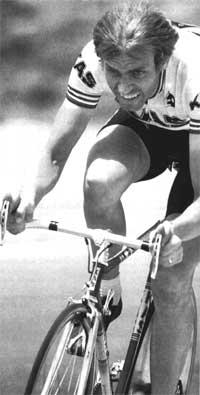
The data published by Stuart Wilson in 1973 in the journal Scientific American show that the lowest consumption of calories per kilometer and gram of body corresponds to the cyclist. Among the animals and machines studied, the mouse was the greatest dissipating energy: 50 calories per kilometer. In the 1982 book Bicycling Science by Frank Whitt and David Wilson, this efficacy was reported from another point of view: the energy that is lost in the transmission of the legs to the rear wheel is only one percentage, with most of this loss corresponding to the entry in the air.
These calculations can be considered in special conditions: in the plane, without wind, average speed (20-25 km/h). And it is that anyone knows that the energy performance of the bike is variable, which is not the same walking on the plain, uphill or down, in a light machine or old, oxidized gadget, on a regular floor or full of batxes, etc. However, the bicycle is recognized, within its limits, which is a very effective instrument.
This efficiency is based on the design of the bicycle. Thanks to this, we use the strongest muscles of the body, of the thighs, to move, in a reasonable cadence and in a comfortable position. On the other hand, the bike has a reasonable weight to move with human strength and a demanding profile of entry to the air.
The improvement of these basic characteristics in the history of the bicycle has been a constant effort of designers and authors. In the search of the machine less resistant to mobility, the objectives to achieve would be to lighten weight, improve the suitability and the functioning of the components and increase the aerodynamics, without forgetting that the resulting vehicle should be manageable, safe and durable, with a reasonable price.
Towards the decade of the 20 of this century began to see bicycles similar to the current ones. Since then, advances have not paralyzed: materials, manufacturing techniques, measures, etc. However, two have been the design features that have remained relatively fixed on most bikes: the trapezoidal frame and radio wheels. However, in recent years, there has been a great revolution in the design of the bicycle. The reason is to get a better aerodynamics.
Improvement of aerodynamics or transformation of the bicycle
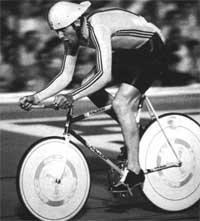
Air resistance is the toughest barrier the cyclist has to move at high speed. When you agi, 90% of the energy that is spent at fast speed is used for it. In fact, this resistance is proportional to the square of the speed, which means that if we want to double our march, we do not have to multiply by four the work we have to do, or that with a speed of 25 km/h, with a double of force, we will only get a speed of 35 km/h, and that the double of force that you are doing pedaling is not a job.
The ease of movement of a solid through a fluid is measured by the Cx penetration coefficient, which is function of the characteristics of both. On the one hand, as the density and viscosity of the fluid increases, movement is difficult. This may be related to the attempt to break many speed records at “high altitudes”. On the other hand, it is necessary to take into account the surface that shows the solid in the direction of advancement and the characteristics that it has to generate a laminar or turbulent flow in the movement through the fluid. The measurements of the Cx coefficient are made in the famous wind tunnel, currently supported in computer design. One of the ways to reduce the fuel consumption of cars is to reduce their Cx.
In the same line, a way to increase the efficiency of the cyclist is the optimization of the Cx of the man-machine pair, and many of the innovations that have transformed the bike in recent years have been the result of the willingness to respond to this goal. The first tests were carried out by Gitane in a wind tunnel, but many places the beginning of this new way of looking at the bike in 1984, when Moser and his technical team used a great technological potential to build an optimal machine that would allow breaking the world record. It is true that since then the bikes used in special races (both individual and collective in timed tests) seem somewhat more and the results are also shown in favor of them. But, how did this equipment improve the aerodynamics of the bike?
First of all, the need to lower the height of the bike-bike system was studied. For this purpose, in order to adopt a more inclined position, the predecessor of the painting headed downwards, tilting the traditional horizontal bar, describing in some sophisticated pictures the curves. The cyclist can get in a more natural way to carry the horizontal back. This new design demanded that the front wheel be smaller and that the handlebars also stick to the frame by a point lower than the previous one. On the other hand, when going “tumbado” by bike, the most comfortable and yet more efficient grip point of the handlebars is the curved aspect, which is the only thing that interests us now. These are two factors that have influenced the creation of a handlebars in the form of “sarde”.
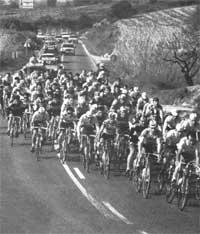
The next problem is to reduce the turbulence generated by the wheel radios when turning. These turbulences occur when hitting the air against the radios. It occurred to someone to address an invention then invented at the end of the last century but never succeeded: the lenticular wheel. At that time he was despised for having more weight than the radio wheels, but the lenticular wheel is much easier to penetrate into the air when the bike runs in a straight line, that is, without curves or without lateral wind.
For purposes like that of Moser, it seemed and was the same. In fact, in the wind tunnel it has been shown that a lenticular in front of a 36 spoke wheel presents a progress of just over a minute in 40 km to 48 km/h. The secondary advantage of this type of wheels is the weight, since due to high inertia it is easier to keep the gear, if you go fast and at constant speed.
The last minute innovation was seen in the last stage of the Tour de France two years ago. Greg Lemond mounts a complementary handlebar type U on the traditional grid type. There is no doubt that if he won for his form and his courage, he has commented on numerous occasions the impact of this special handlebars on victory. Nor was the controversy lacking, arguing whether that complement was acceptable today according to the rules of the International Cycling Society. However, the U-type handlebar was not used by Lemond as a stranger.
Already in the triathlon tests, a similar handlebar has been assiduously seen, instead of being an auxiliary piece type U, made with a single bar. The question is that some tests carried out in wind tunnel showed that a greater penetration coefficient is achieved, decreasing the surface in width compared to the height. For this purpose, the key was to stretch the arms forward. The use of a handlebars of these characteristics is an advantage of two seconds per kilometer at 40 km/h. Others claim that the distance of 40 km is 90 seconds faster. In addition, it seems that the cyclist breathes more calmly and gets a more suitable position to make strength.

The section of the painting has changed lately. The standard frame has a circular section (circumferential) and for a long time it is known that when moving through a fluid turbulence occurs in the back of the solid in this form. Tear section is shown to be the most suitable for generating laminar flow. This section is called aerodynamic foil. Currently, it has begun to build paintings based on this idea.
To the previous innovations, we must add, of course, the taste of the cyclist himself. In other words, the clothes worn by the cyclist must facilitate the maximum entrance of the aisa in the air. That's why it uses specially designed helmets (also aerodynamic foil, stretched from the back), silk t-shirts,...
When using all these new elements, the difference is not slow. The Soviet Union team, world champion in the 100 km anti-clock test, estimated that the advantage was 10 minutes.
Improvement of aerodynamics by little value
If one of the most important tasks the cyclist has is to overcome the resistance of the air, it could be thought that anything that implies an improvement in it should have an immediate application. But apart from the time trial tests, the appearance of the bicycle is maintained mainly. Why?
In the normal stage (once online), the Carreristas go in a platoon and it is evident that not everyone will endure air resistance to the same extent. Everyone who has gone by bike in the crew knows perfectly how hard it is to go throwing in front while others go together to our wheel. While cyclists go behind the christening, it is shown that the first should keep about 20 heart beats more than the second to run at 35 km/h. This rate of pulsation is decreasing, although to a lesser extent, of the second.
In positions 6 or 7, on the other hand, turbulence problems occur and air protection becomes more uncertain. In any case, going inside a strong platoon can be a bit calm, as you need or need half of the energy that goes ahead. And we've said "it can be," because your works, if we're going to have peace with neighboring friends, are going to be maintaining balance and going properly. This is the ability of years of experience.
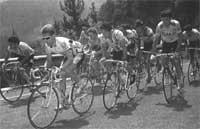
If someone leaves the platoon, they will have to leave with a lot of acceleration and be careful that no one will stick behind, since if we “hook the wheel” it is difficult to leave it behind. We need, therefore, a machine of great acceleration, not very heavy and with good manageability so that, as we have said, the changes of direction that we must perform if we do not want anyone to position in our back of advantageous way, are fast and safe.
In the mountain stage things change even more. When climbing the slope, the main force to overcome is not the resistance of the air, but the gravitation. The same energy consumption allows lower speeds. Comparatively, the energy needed to maintain a speed of between 25 and 30 km/h in the room only serves to increase the slope of 7% at a speed of 10-12 km/h. Because the resistance of the air varies with respect to the square of the speed, this march is negligible with respect to the gravitational force.
On the slope we would hear many of the Carreristas that are worth one's forces, because going behind another is not as beneficial as in the league. The optimal Cx will not then have as much importance as in the launa, and it will have to be fixed on the weight of the machine. We need more light and fast response machine than ever.
Another aspect to take into account is the posture; although there are different techniques to climb a slope, in all of them it is necessary to grab the handlebars in a relatively high position. The cyclist generally adopts a more upright position, being the most common grip points the horizontal part of the handlebars or the control of the brakes. We will hardly see someone going up the curved side of the handlebars a hard hill.
Therefore, it is evident why the innovations previously exposed are not used in the launas and mountainous stages of the line. The lenticular wheels, for example, reduce the capacity of acceleration of the bike due to its greater weight. In addition, when the wind blows from the side, this type of wheel greatly dampens the machine and can even unbalance it. The use of the lenticular wheel also in the time tests is not a decision without more. It is necessary to look well at the risk of wind and the characteristics of the route (curves, slopes, length, etc. ). Let's not say in the line stage, if we take into account the weather conditions and the demands of running in the platoon: no one uses it.
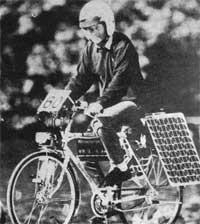
On the other hand, the aerodynamic design of the frame and handlebars reduces the handling of the bicycle and adaptability to the different moments and environments of the route. The low profile bike does not reach the curves with the same ease as conventional ones and greatly consolidates the position of the cyclist while the conventional handlebar offers comfort to change posture.
The additional handlebar type U, "irrintzia" last minute, requires a lot of technique and courage in the curves. The direction of the bike is very sensitive, and if it does not go directly it is quite unstable, you have to drive very precisely. Proof of this is that in the time trial tests it is also used together with a wide handlebar (both conventional and goat horn) due to the risk that in the curves it goes against the barrier.
In the coming years there will be no lack of improvement or renovation in the design of the bicycle, but in any case, if the design based on trapezoidal frames and radio wheels has a temporary life and probably not short.
Do not believe, however, that innovations have only come to improve aerodynamism. It has already been mentioned in previous lines the need for a lightweight bicycle and fast response. Other times we should talk about damping or damping capacity and stability. These characteristics must be the most appropriate to the demands imposed by the different uses. To explain them, next time, we should talk about the materials and geometry of the painting.





